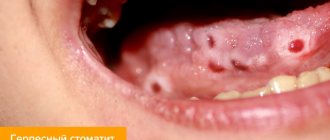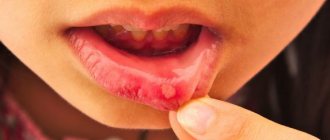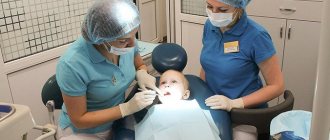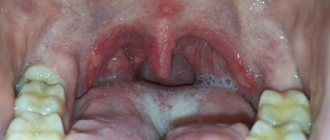Dermatovenerologist
Khasanova
Alina Rashidovna
9 years experience
Make an appointment
Patients often consult a doctor complaining of inflammation in the red border or mucous membrane of the lips. In most cases, a specialist diagnoses “cheilitis”. This is the name for tissue inflammation, which manifests itself in the form of redness, peeling, the appearance of purulent crusts and weeping ulcers. Any attempt to open the mouth when eating or communicating causes sharp pain associated with tissue damage. Without proper treatment, the disease persists for a long time, causing the patient a lot of physical and aesthetic inconvenience. For young people, the prognosis after clinical treatment of cheilitis is completely favorable, but older patients may encounter its complications in the form of leukoplakia and the onset of the oncological process.
Reasons for development
In the clinical practice of most specialists, there are cases where cheilitis on the lips developed on its own or was a side effect of a serious disease of the internal organs or damage to the mucous membrane. Among the most likely causes of the development of the disease are:
- inflammation of the mucous membrane with dermatoses, erythematoses or lichen planus;
- infectious diseases: syphilis, tuberculosis, etc.;
- psoriasis and other skin problems.
Among the unfavorable external factors, it is worth noting an excessive amount of ultraviolet radiation, strong wind, flows of cold or hot air from climate control equipment or ventilation in industrial premises. Signs of cheilitis are often observed in people who work in open areas in direct sunlight.
A separate group includes manifestations of allergic cheilitis, which developed after contact of the lip mucosa with aggressive chemicals or prolonged exposure to ultraviolet radiation. Sometimes doctors observe the clinical picture of secondary cheilitis, when the development of the disease is caused by eczema, neuritis of the facial nerve, pathologies of the muscles and tissues of the facial part of the skull.
Diagnostics
Although the external manifestations of the disease are quite characteristic, for a complete clinical picture it is necessary to use histological examination. A biopsy of the affected salivary gland will help establish the most accurate diagnosis. Changes in epithelial tissue in patients may vary from person to person: in some patients parakeratosis or acanthosis may be noticed, while in others no changes occur. Cheilitis is characterized by the absence of the granular layer of the epithelium, while the spinous and basal layers, as a rule, remain unchanged.
Symptoms and signs depending on the type of cheilitis
The accepted classification of cheilitis makes it possible to clearly establish the type and causes of the disease, as well as to identify the characteristic signs of the pathological process:
- Exfoliative cheilitis is localized on the red border of the lips. It has a clear gender link: it occurs more often in women. The main symptom is peeling of the lips due to neurological disorders: stress, depression, anxiety. Often the inflammatory process develops against the background of hyperthyroidism, or intense activity of the thyroid gland. The danger of exfoliative cheilitis is its ability to be inherited as a genetically fixed change in the body’s immune system.
A feature of exfoliative cheilitis is localization only on the red border of the lips, while the mucous membrane and skin around the mouth remain intact. In most cases, only part of the border is affected, while areas at the corners of the mouth usually retain their appearance. If a patient has dry skin, he often complains of tightness of the lips, the appearance of scales, and a burning sensation. It is almost impossible to completely cure exfoliative cheilitis. The disease proceeds along a sinusoid, sometimes exacerbating, sometimes disappearing under the influence of medications and external factors. Without medical supervision and if you refuse to take a course of treatment, large bleeding crusts form on the lips, which cause discomfort during conversation and eating.
- Glandular cheilitis develops against the background of pathological proliferation of the salivary glands. A humid environment creates favorable conditions for pathogenic microorganisms, as a result of which the mucous membrane becomes easily infected. If the pathology of the salivary glands is congenital, the probability of developing glandular cheilitis is 100%. The risk group also includes patients with dental problems: untreated caries, periodontitis, tartar, etc.
In some cases, glandular cheilitis develops as a result of damage from waste products and the breakdown of pathogenic microorganisms. The disease is more often diagnosed in patients over 30 years of age and is localized on the lower lip. Primary symptoms are dry lips and the appearance of painful cracks. Usually these symptoms are ignored, and attempts are made to combat them with local cosmetic products. Without treatment, the problem worsens: erosions and bleeding wounds appear at the site of cracks. Involuntary licking of dry lips aggravates the pathological process, which leads to their further dryness.
- Contact allergic cheilitis is caused by exposure to an external allergen. This could be the chemical composition of lipstick, microorganisms on the surface of pencils or pens, which the patient is accustomed to often holding in his teeth during work or creative activities. Cheilitis is considered an occupational disease among musicians who are forced to hold the mouthpieces of instruments in their mouths for a long time. The symptoms of this type of pathology are quite common. Patients complain of itching, swelling, burning and inflammation of the lips. After prolonged contact with the allergen, blisters appear on the skin, the rupture of which opens small ulcers and erosions. In the chronic stage, the disease makes itself felt only with minor itching and peeling.
- Meteorological or actinic cheilitis is a reaction to weather conditions. For a sensitive organism, radiation, wind, cold or solar radiation are equally dangerous, provoking the appearance of characteristic symptoms: burning and itching, large crusts and erosion of the mucous membrane. With prolonged exposure to unfavorable climatic factors, the formation of small bubbles with liquid contents is possible. The dry form of cheilitis is considered the most dangerous for patients. Its first symptoms in the form of itching and burning are harmless. However, with prolonged development and lack of treatment, malignancy is possible - the degeneration of affected cells into a malignant formation.
- Atopic cheilitis is a type of skin disease: atopic dermatitis and neurodermatitis. The disease develops against the background of an allergic predisposition of the body, which reacts to cosmetics, perfumes, food and exposure to pathogenic bacteria. In addition to the usual symptoms, there is dryness and damage to the skin in the corners of the mouth, and intense peeling of the face.
- Hypovitaminous cheilitis develops against the background of a lack of B vitamins in the body. Patients usually complain of dryness and burning of the tongue and lips. Vertical cracks and small peeling scales are visible on the skin. The tongue increases in size, and teeth marks become visible on it.
Are you experiencing symptoms of cheilitis?
Only a doctor can accurately diagnose the disease. Don't delay your consultation - call
Pathogenesis
The pathogenesis of various cheilitis varies significantly. For example, the pathogenesis of glandular cheilitis is based on acquired/congenital proliferation of the minor salivary glands, which often contributes to their infection and the development of intoxication with toxins /waste products of bacteria/viruses. The pathogenesis of meteorological (actinic) cheilitis is increased sensitivity to ultraviolet radiation, cold, wind, and radiation. The development of contact allergic cheilitis is based on a response to exposure to an irritant, and atopic cheilitis is an allergic predisposition, hypovitaminous cheilitis is a deficiency of B vitamins, and so on.
In general, it should be noted that cheilitis develops when a violation of the architectonics of the lips is combined with an inadequate reaction of the integumentary tissues (red border, skin, mucous membrane) of the lip to external/internal environmental factors (reduced resistance to mycotic, pyogenic and microbial microflora, a tendency to keratoderma, allergic reactions). Also in the pathogenesis of cheilitis, the metabolic function of the skin/mucous membrane of the lip is of significant importance, for example, the high ability of the skin/mucous membrane to absorb various substances from the surface.
Treatment of various types of cheilitis
The course is developed taking into account the type of diagnosed disease and the general condition of the body.
- For exfoliative cheilitis, additional consultations with a neurologist and neuropsychiatrist are recommended. The patient is prescribed a course of sedatives. Effective methods of local treatment include laser therapy, ultrasound or radiation therapy, and the use of moisturizing cosmetic creams and ointments. According to indications, hormonal medications and vitamin complexes are prescribed.
- Glandular cheilitis is removed with anti-inflammatory ointments. Local treatment consists of cauterization or desquamation of enlarged salivary glands, and during the rehabilitation period, the use of drugs to eliminate dryness or excess moisture of the mucous membrane.
- When treating atopic cheilitis, the goal is to eliminate any irritating factors. The local course is based on the use of anti-inflammatory and anti-allergic drugs in the form of external ointments. Patients are also recommended to have a hypoallergenic diet that excludes the consumption of fish, citrus fruits, spicy foods and alcohol.
- For meteorological cheilitis, treatment tactics include taking vitamin preparations, using local healing agents and ointments with a high UV filter.
Timely initiation of treatment and the patient completing its full course guarantees relief from the unpleasant symptoms of cheilitis with a long-term effect.
How the problem manifests itself
HC “announces itself” with classic symptoms - characteristic red dots appear on the border of the lips (seen in the photo above). These are nothing more than the mouths of the salivary glands affected by the disease. If you blot your lips, after a short period of time droplets of secretion will appear on them again. Due to the fact that saliva is produced in excess of normal, the surface of the lips is constantly moisturized. But due to the constant evaporation of liquid, the skin, accustomed to “humidity,” cracks and flakes.
Secondary GC is a complication of skin diseases, pathological processes in the oral cavity, the result of smoking and neglect of the rules of caring for teeth and gums
In some patients, the course of HC is associated with constant itching in the affected area. At the same time, the “affected” skin looks rough, unhealthy, the epithelium becomes keratinized and dry. White ring-shaped formations often appear around the mouths of the salivary glands - these are foci of leukoplakia. The purulent form of cheilitis most typically manifests itself. Thus, the lips swell, become extremely sensitive to any mechanical damage, and are very painful.
On examination, the skin looks red, swollen, thinned, flaky, the epithelium is covered with multiple purulent crusts. Upon palpation, enlarged, compacted salivary glands are determined, when pressed, a secretion mixed with purulent exudate is released. In the complicated course of Volkmann's cheilitis, local signs of inflammation are accompanied by symptoms of general intoxication of the body, enlargement of the submandibular lymph nodes, and abscess formation of the lips.
Prevention
As you know, prevention is cheaper than treatment. In addition, preventing a disease is much easier than curing it, although this will require regularly following some rules.
Pay more attention to oral hygiene. To prevent the formation of cracks, it is necessary to protect the skin and mucous membranes of the mouth from adverse effects: unlearn the habit of licking the lips and corners of the mouth, use medicinal cosmetics for dry skin (lipstick, balm, cream). To avoid infection of the skin of the lips from the oral cavity, it is necessary to regularly brush your teeth, see a dentist, and promptly treat caries and inflammatory gum diseases.
Follow the rules of nutrition. If cracks appear in the corners of the mouth, exclude from the diet spicy, sour and salty foods that irritate the mucous membrane and skin. Include less acidic fruits and vegetables in your daily diet, as well as foods containing iron and riboflavin (beef, liver, dairy products, cabbage, potatoes, peanuts, almonds and others).
Give up bad habits. Smoking is a provoking factor in the development of this disease.
Allergic
Allergic cheilitis most often occurs in women after twenty years of age and is characterized by swelling, severe burning, itching and redness of the lips. Sometimes, with a severe allergic reaction, small blisters form on the skin, which burst, leaving behind cracks and erosions.
The reason is a tendency to allergic reactions and direct multiple contact with the allergen. Allergic contact dermatitis can be caused by any substance: lanolin from lipstick, components of toothpastes and dentures, paint from foreign objects, metal and anything that touches the lips. When allergic cheilitis occurs, treatment consists of identifying the allergen and eliminating it.










